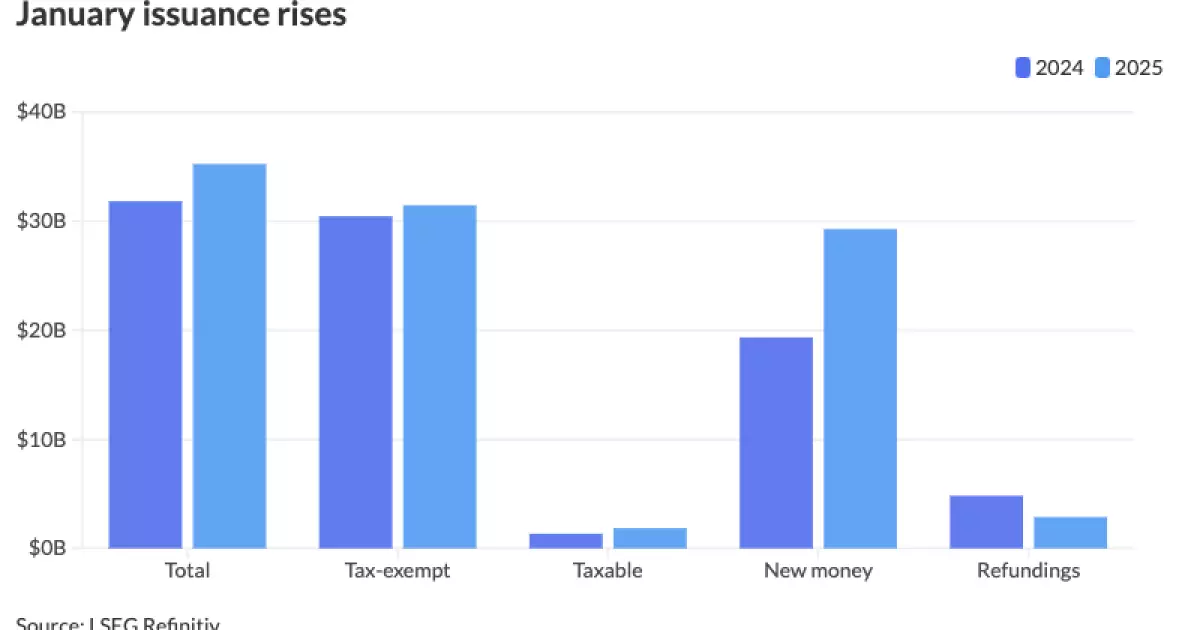January Bond Issuance: A Surge Amid Economic Uncertainty

The financial landscape at the beginning of 2025 indicates an unexpected and robust upswing in bond issuance, revealing underlying complexities that center around economic uncertainties, fiscal policies, and market behavior. Analyzing the latest data, it becomes clear that various strategic initiatives and external factors contributed to a windfall of new issues amid a cautious economic climate.
In January, the total bond issuance reached an impressive $35.243 billion across 486 issues, marking a significant increase of 10.8% compared to the previous year’s $31.817 billion from 554 transactions. This notable rise stems not only from a desire for liquidity but also from a strategic urgency to capitalize on market conditions before potential policy shifts occur. As highlighted by data from LSEG, the current figures breach the 10-year average of $28.675 billion, underscoring a strong demand despite overarching economic apprehensions.
The sentiment among issuers appears to indicate a proactive approach fueled by perceived volatility in potential fiscal changes, particularly in light of anticipated shifts stemming from new administrative directives. Credit analyst Alice Cheng from Janney emphasized that the Federal Open Market Committee (FOMC) meetings generate considerable investor concern, complicating decisions around interest rates, which currently reside between 4.25% and 4.50%. Issuers have evidently opted for a more immediate market presence rather than risk future market fluctuations and regulatory uncertainties.
Several influential factors appear to have propelled issuance rates. Foremost among these is the hesitancy surrounding the Infrastructure Investment and Jobs Act, with concerns revolving around potential retractions of allocated funds. Cheng notes that due to fears surrounding the availability and use of these funds, many issuers have chosen to act rather than remain in a wait-and-see posture. This push reflects a broader attempt to buffer against unexpected shifts in economic governance.
Additionally, evolving tax landscapes present a further impetus for increased bonding activity. With chatter around possible changes to tax exemptions, particularly impacting healthcare and private education institutions, issuers may have taken advantage of current conditions to solidify funding. James Pruskowski, CIO at 16Rock Asset Management, suggested that this rapidly shifting environment contributes to issuance pacing, as stakeholders strive to secure favorable terms before any fiscal adjustments take effect.
Market analysts widely agree that a considerable backlog of projects and financial initiatives have become unstuck as issuers regain confidence. Pruskowski articulated that missed opportunities from the previous year’s heightened volatility resulted in a reinvigorated urge among issuers to engage the market actively. As financial conditions have softened since the peaks of recent months, the stage is set for a correspondingly stronger demand.
Rob Dailey, head of PNC Public Finance, noted that the anticipated momentum will likely extend throughout 2025. This optimism is bolstered by federal infrastructure funding, which has catalyzed state-led projects in sectors ranging from affordable housing to transportation. Such initiatives are expected to drive demand within the bond markets and banking sector for the foreseeable future, ensuring continued activity within this vital financial segment.
Diving deeper into the statistics for January, the patterns reveal distinct trends across various categories. Tax-exempt issuance climbed to $31.45 billion from last year, and taxable issuance saw a staggering rise of 36.7% to $1.849 billion. These figures underline the urgency felt by issuers, with a marked shift toward new-money funding—up 51.4%—contrasting with a decline in refundings.
Interestingly, while revenue bonds gained prominence, with an increase of 14% from January 2024, the momentum was not uniformly sustained. General obligation bond sales expanded moderately, while bank-qualified issuance saw a notable decline. These dynamics present a composite view of a market in flux, characterized by strategic pivots as stakeholders respond to internal and external forces.
Regionally, California emerged as the dominant player in bond issuance, securing $6.371 billion, reflecting a 12.6% year-on-year increase. Other states like Texas and Florida followed suit, contributing to the overall eagerness to tap into available funding sources. However, the inconsistency among regions, such as Massachusetts’s decline of over 50%, illustrates the localized nature of these financial opportunities and challenges.
The January bond market has experienced a significant uplift amid uncertain economic conditions, with numerous factors motivating issuers to enter the market ahead of volatility. The interplay between strategic financial planning and changing policy landscapes will likely shape the momentum of bond issuance throughout 2025, revealing continued opportunities amidst challenges.





